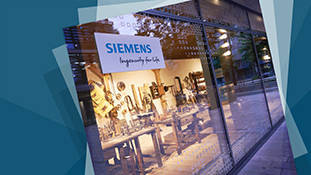On October 12, 1847, the predecessor of today’s Siemens AG was founded in a workshop tucked away at the back of a Berlin courtyard. In the course of the 170 years that followed, Siemens constantly reinvented itself, survived crises, and continuously adapted its portfolio – thus proving itself capable of change. Today, Siemens is one of the leading companies in the field of digitalization. Over the decades, certain constants – such as internationality, a quality mindset and customer orientation – have remained guarantors of success. The guiding principle behind all this? “Whatever we do must offer long-term benefits and generate value – for our shareholders, employees and customers as well as our business partners and society,” said Siemens AG President and CEO Joe Kaeser.
The invention of the pointer telegraph in 1847 and the discovery of the dynamo electric principle in 1866 laid the foundation for Siemens’ success. Werner von Siemens is considered one of the founders of modern electrical engineering. The “Telegraphen-Bauanstalt von Siemens & Halske” telegraphy company launched with 10 employees. This small workshop – which, in addition to telegraphs, manufactured electrically triggered railroad warning bells, wire insulation, and water meters – advanced to become one of the world’s largest electrical engineering and technology companies within just a few decades. Over its 170-year history, the company has overcome major challenges, including the consequences of two world wars and the associated loss of assets. It also had to deal with a compliance crisis which started a little over ten years ago, and from which Siemens ultimately emerged as a role model for clean business. Today, with around 350,000 employees, Siemens has rigorously geared its activities towards the fields of electrification, automation and digitalization. The company’s early orientation toward the area of digitalization aligns well with the other major milestones from the company’s history. Today, Siemens is a leader in the area of digitalization and uses MindSphere, for instance, to connect machines and systems with the cloud in order to create completely new business models. The company laid the cornerstone for its digital expertise as early as ten years ago. Since then, Siemens has invested more than €10 billion to further expand its position as one of digitalization’s driving forces.
Internationalization as a pathway out of crises
Since its early days, the company has repeatedly demonstrated the ability to chart new territory. The sales crises on Prussia’s telegraph market in the 1850s forced Siemens to find new markets and aim for international expansion – for instance by building a 9,000-kilometer telegraph line in Russia and by laying submarine cables from England. After the establishment of offices in London in 1850 and St. Petersburg in 1855, other Siemens locations quickly followed around the world. To name just a few: Brussels in 1871, Paris and the Hague in 1878, Vienna and Warsaw in 1879, Stockholm and Turin in 1880, New York in 1886, Tokyo in 1887, Rio de Janeiro in 1888, Budapest in 1890, Chicago in 1892, and Johannesburg in 1895. Today, Siemens is active in nearly 200 countries.























